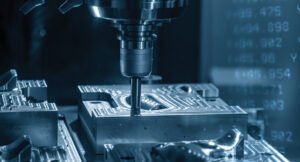Machining technology plays a crucial role in the manufacturing industry, involving the use of various tools and machines to remove metal materials and form precise parts and components. However, during the machining process, technicians may encounter a series of problems that may affect production progress, product quality, and cost.
Tool Wear and Breakage
Cutting tools may wear or break during the machining process, leading to a decrease in machining accuracy and production delays.
Reason:
High cutting force, unsuitable tool path and geometry, insufficient tool strength
Solution:
Regularly inspect and replace cutting tools, use high-quality tool materials, and ensure the use of correct cutting parameters. In addition, coating tools can be considered to extend tool life.
Material Deformation
When unexpected bending, twisting, or shape changes occur in the design of machined parts, CNC machining deformation occurs
Reason:
During the processing, due to thermal and mechanical stresses, the material may deform, resulting in inaccurate part dimensions.
Solution:
Optimize cutting parameters, such as cutting speed, feed rate, and cutting depth, to reduce the generated heat. Alternatively, use coolant to control the temperature of the workpiece.
Irregular Surface Finish
The rough texture, lines, or unevenness on the surface of processed components directly affect their functionality and aesthetics.
Reason:
Vibration and vibration: Excessive vibration of CNC machine tools or cutting tools can cause surface roughness. This is usually caused by dull cutting tools, incorrect CNC milling strategies, or insufficient cooling.
Inappropriate cutting parameters: Incorrect settings, such as too fast feed rate, can cause tool vibration and leave uneven marks.
Solution:
Regular maintenance: Ensure that the cutting tools are sharp and use the correct milling strategy. Continuous maintenance can prevent the tools from becoming dull
Optimizing cutting parameters: Properly adjusting the feed rate and spindle speed can achieve better surface smoothness.
Burn Marks
The burn marks on the surface of the workpiece indicate overheating during the machining process, usually manifested as discolored patches on the machined parts.
Reason:
Incorrect cutting parameters: Improper combination of feed and speed selection may cause serious damage due to overheating.
Insufficient cooling: Lack of sufficient cooling can lead to overheating, especially for materials with poor thermal conductivity such as titanium.
Solution:
Adjusting speed: Reducing the cutting speed relative to the feed rate can lower the machining temperature, and improving the cooling speed of the machining process is also crucial.
Enhanced cooling strategy: For materials with poor thermal conductivity, it is necessary to simultaneously reduce speed and enhance cooling.
Heat Damage
Due to excessive heat generated during CNC machining, thermal damage is caused.
Reason:
Usually caused by high-speed operation, insufficient cooling, or excessive tool friction.
Solution:
The key solutions include ensuring sufficient cooling, selecting the appropriate cutting speed, maintaining tool sharpness, and adjusting feed rate and spindle speed. Improving the cooling rate during the machining process is also crucial, especially for materials such as titanium with poor thermal conductivity.
Conclusion
Problems during the machining process may seriously affect production efficiency and product quality. By understanding these common problems and their solutions, technicians can take preventive measures to improve processing efficiency and ensure the production of high-quality parts.
Thank you for reading our article. If you need related products or have any questions or suggestions about our products, please don’t hesitate to contact us by sending an email, and we will reply to your email as soon as possible.

